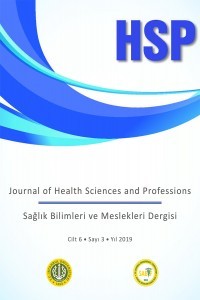Hemşirelik ve Ebelik Öğrencilerinde Malpraktis
: Ebe, hemşire, intörn öğrenci, malpraktis
Malpractice In Nursing and Midwifery Students
malpractice, midwife, nurse, Malpractice,
___
- JCAHO (2006). Sentinel Event Statistics,www.jointcommission.org/Library/TM_ hysicians/ mp_11_06.htm, Erişim tarihi:01.06.2016
- Özata M, Altunkan H. Hastanelerde Tıbbi Hata Görülme Sıklıkları, Tıbbi Hata Türleri Ve Tıbbi Hata Nedenlerinin Belirlenmesi: Konya Örneği [ Fruquency of medical errors in hospitals, determination of medical errors types and medical errors:Konya Sample],Tıp Araştırmaları Dergisi, 2010:8(2);100-11.
- Aygin D. Cengiz H. İlaç uygulama hataları ve hemşirenin sorumluluğu [Drug administration errors and the responsibility of a nurse], Ş.E.E.A.H. Tıp Bülteni [The Medical Bulletin of Şişli Etfal Hospital], 2011: 45(3);110-114.
- Pınar Güngör, Yeliz Doğan Merih, Meryem Yaşar Kocabey, “Farklı Ülkelerin Malpraktis Konusunda Yasal Düzenleme Girişimleri, Zorunlu Mali Sorumluluk Sigortası”[Legal Arrangement Attempts of Different Countries about Malpractice: Compulsory Financial Liability Insurance Approaches ] Zeynep Kamil Tıp Bülteni [Medical Bulletin of Zeynep Kamil] , 2012 :43(4)
- Tuba Saygın, Belma Keklik, “Tıbbi Hata Nedenleri Üzerine Bir Araştırma: Isparta İli Örneği”[ A Study About Causes of Medical Errors: Isparta Province Sample]Hacettepe Sağlık İdaresi Dergisi [ Hacettepe Journal of Health Administration], 2014;17(2)
- Bilge Y, Geçim E .Medikolegal Düzlem Tıpta Uygulama Hataları [Medicolegal Platform For Malpracticeısbn], 1. Baskı, Ankara, Matbaa Promosyon ve Reklam hizmetleri, 2013. p 7-13.
- Akalın HE. Yoğun Bakım Ünitelerinde Hasta Güvenliği [ Patient Safety in Intensive Care Units],Yoğun Bakım Dergisi [ Turkısh Journal Of Intensıve Care Medıcıne] , 2005; 5 (3):141-146.
- Menachemi N, Shewchuk RM, O’Connor SJ, Berner ES, Allison JJ. Perceptions of Medical Errors by Internal Medicine Residents: Development and Validation of a New Scale. Quality Management in Health Care, 2005: 14 (3); 144-154.
- Işık O, Akbolat M, Çetin M, Çimen M. Hemşirelerin bakışıyla tıbbi hataların değerlendirilmesi (The Causes of Medical Error From the Perspective of Nurses), TAF Preventive Medicine Bulletin, 2012:11(4);421-430.
- Kohn, Linda T., Janet M. Corrigan, and Molla S. Donaldson, eds. To err is human:: building a Safer Health System. Vol. 6. National Academies Press, 2000.
- Tütüncü Ö. Küçükusta D, Hasta Güvenliği Kültürü ve Hemşirelere Yönelik Bir Uygulama [An Application on Patient Safety Culture and Nurse], Hastane Yönetimi Dergisi, 2006;10(2):61-68.
- Ertem G, Oksel E, Akbıyık A, Hatalı Tıbbi Uygulamalar (Malpraktis) ile İlgili Retrospektif Bir İnceleme [A Retrospective Review About The Malpractice Applications in Medicine], Dirim Tıp Gazetesi 2009; 84(1 ): 1-10
- Özata M, Altunkan H. Hemşirelikte Tıbbi Hataya Eğilim Ölçeğinin Geliştirilmesi, Geçerlilik ve Güvenilirlik Analizinin Yapılması [Development of Malpractice Trend Scale in Nursing and Validity and Reliability Analysis], II. Uluslararası Sağlıkta Performans ve Kalite Kongresi Bildiriler Kitabı. Ankara: 2010b
- Sharek PJ, Classen D. The İncidence of adverse events and medical error in pediatrics,Pediatric Clinics Of North America, 2006;53:1067-1077
- Alemdar, D. K., Aktaş, Y. Y. Türkiye'de Hemşirelik Hizmetlerinde Tıbbi Hata Türleri ve Nedenleri [Medical error types and causes made by nurses in Turkey) TAF Preventive Medicine Bulletin 2013; 12(3) :307-314
- Sezgin B. Kalite Belgesi Alan Hastanelerde Çalışma Ortamı ve Hemşirelik Uygulamalarının Hasta ve Hemşire Güvenliği Açısından Değerlendirilmesi [Evaluation of work environment and patient and nurse safety of nursing practices in hospitals which have received qyality certificate] [Doktora Tezi], İstanbul Üniversitesi, Sağlık Bilimler Enstitüsü [Institute of Medical Sciences, Haliç University] , İstanbul,2007.
- Cebeci F. Gürsoy E. Tekingündüz S. Hemşirelerin Tıbbi Hata Yapma Eğilimlerinin Belirlenmesi [Determining the Level of Tendency in Malpractice Among Nurses], Anadolu Hemşirelik ve Sağlık Bilimleri Dergisi [Journal of Anatolia Nursing and Health Sciences ], 2012; 15: 3
- Avşar G, Atabek Armutçu A, Karaman Özlü Z. Determining the Level of Tendency in Malpractice of Nurses: A Hospital Sample. HSP 2016 3(2):115-122.
- Özkan S, Kocaman G, Öztürk C, Seren S. Frequency of pediatric medication administration errors and contributing factors. Journal of Nursing Care Quality, 2011; 26(2):136-143.
- Ersun A, Başbakkal Z, Yardımcı F, Muslu G, Beytut D. Çocuk hemşirelerinin tıbbi hata yapma eğilimlerinin incelenmesi [ A Study Of The Malpractıce Trends In Pedıatrıc Nurses ] Ege Üniversitesi Hemşirelik Fakültesi Dergisi [ Journal of Ege Unıversıty Nursıng Faculty], 2013; 29(2):33-45.
- Cebeci F. Gürsoy E. Tekingündüz S. Hemşirelerin Tıbbi Hata Yapma Eğilimlerinin Belirlenmesi [Determining the Level of Tendency in Malpractice Among Nurses], Anadolu Hemşirelik ve Sağlık Bilimleri Dergisi [Journal of Anatolia Nursing and Health Sciences ], 2012; 15: 3
- Avşar G, Atabek Armutçu A, Karaman Özlü Z. Determining the Level of Tendency in Malpractice of Nurses: A Hospital Sample. HSP 2016 3(2):115-122.
- Özkan S, Kocaman G, Öztürk C, Seren S. Frequency of pediatric medication administration errors and contributing factors. Journal of Nursing Care Quality, 2011; 26(2):136-143.
- Ersun A, Başbakkal Z, Yardımcı F, Muslu G, Beytut D. Çocuk hemşirelerinin tıbbi hata yapma eğilimlerinin incelenmesi [ A Study Of The Malpractıce Trends In Pedıatrıc Nurses ] Ege Üniversitesi Hemşirelik Fakültesi Dergisi [ Journal of Ege Unıversıty Nursıng Faculty], 2013; 29(2):33-45.
- ISSN: 2148-7588
- Başlangıç: 2014
- Yayıncı: İstanbul Üniversitesi-Cerrahpaşa
Türkan AKYOL GÜNER, Sibel KIRAN
Gebelikte İlaç Kullanımı ve Danışmanlık
Mukaddes MİRAL, Nezihe KIZILKAYA BEJİ
Sağlık Yönetmi Stajyer Öğrencilerinin Yeterliliklerinin Değerlendirilmesi: Bir Alan Araştırması
Hemşirelik ve Ebelik Öğrencilerinde Malpraktis
Gülcan BAHÇECİOĞLU TURAN, Talip MANKAN, Hilal POLAT
Türkiye’de Palyatif Bakım Hizmetleri
Ebelerde Örgütlenme ve İş Doyumunun Belirlenmesi
Zümrüt BİLGİN, Meryem YAŞAR KOCABEY, Gülsüm YEŞİLYURT, Derya ÖZTÜRK
Sağlık Bilimleri ve Meslekleri Dergisi Yıl 2017 Sayı 2
Sağlık Bilimleri ve Meslekleri Dergisi HSP
Türkiye’de Ebelik Bölümlerinin Akademik ve Fiziki Profili
Yeliz ÇAKIR KOÇAK, Hafize ÖZTÜRK CAN, Ummahan YÜCEL, Mahide DEMİRELÖZ AKYÜZ, Esin ÇEBER TURFAN
Üniversite Öğrencilerinin Kan ve Organ Bağışına İlişkin Düşünceleri
